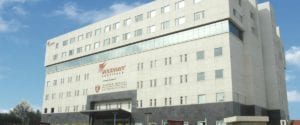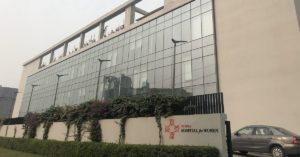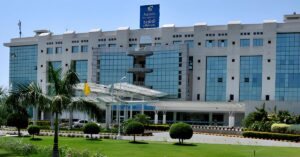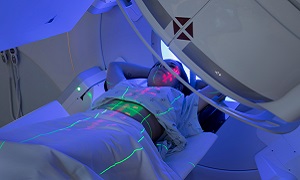Best Doctors in India for Osteosarcoma Treatment
Best Hospitals in India for Osteosarcoma Treatment
- City: Mumbai, India
Hospital Highlights:
- Fortis Hiranandani hospital was established in 2007.
- The hospital is an advanced tertiary care, multi-specialty hospital equipped with 149 beds.
- The hospital is equipped with a super ICU to provide emergency medical care to critically ill patients.
- The hospital is NABH accredited.
- The critical care facility in the hospital is augmented with the state-of-the-art facilities that facilitate speedier diagnosis and efficient monitoring.
- The hospital provides specialty medical services in cardiology, orthopedic science, pediatric science, neurology, diabetic care, urology, nephrology, ENT, obstetrics, gynecology, cosmetic surgery, bariatric surgery, neuro and spine care.
- City: Gurugram, India
Hospital Highlights:
- W Pratiksha Hospital, Gurugram, is one of the best hospitals in the NCR region. It is also a top hospital in India for IVF. Since its inception, the hospital has performed over 5500 successful IVFs. The hospital also specializes in gynecology.
- With over 20 years of experience in providing quality healthcare, the hospital is known as one of the most trusted and valued health providers in India.
- Equipped with world-class medical facilities and advanced technology, the hospital’s doctors and clinicians also have a track record of delivering excellent results. The hospital is also known for focusing on preventive well-being as much as on curative treatment.
- The hospital has earned the trust of its patients, by providing the best available treatments at affordable costs.
- City: Gurugram, India
Hospital Highlights:
- Paras hospital was established in 2006 and is the 250 bedded flagship hospital of Paras Healthcare.
- The is supported by a team of doctors of international and national repute.
- The hospital is NABH accredited and also the first hospital in the region to have a NABL accredited laboratory.
- The hospital provides specialty medical services in around 55 departments including Neurosciences, Joint Replacement, Mother & Child Care, Minimal Invasive Surgery, Gynecology and Obstetrics, Ophthalmology, Dermatology, Endocrinology, Rheumatology, Cosmetic and Plastic surgery.
- The hospital is equipped with state-of-the-art technologies.
- City: Kolkata, India
Hospital Highlights:
- Fortis Hospital, Anandapur, Kolkata is a world-class super-speciality equipped with the latest technologies in the medical world.
- The hospital is NABH accredited.
- This state-of-the-art facility specializes in cardiology and cardiac surgery, urology, nephrology, neurosciences, orthopaedics, digestive care, emergency care and critical care.
- The hospital, governed by integrated Building Management System (IBMS), has a pneumatic chute system, for quick vertical and horizontal transportation between floors, facilitating speedy transfer of patient specimens, documents, reports, and medicines to the concerned departments.
- The hospital also has a nephrology department with over 28 advanced dialysis units.
- City: Mumbai, India
Hospital Highlights:
- SL Raheja hospital is a 140-bed multi-specialty tertiary care hospital that is being managed by Fortis Healthcare Ltd.
- The hospital is a benchmark in healthcare and medical facilities in the neighborhood of Mahim & the western suburbs.
- L.Raheja Hospital, Mahim has one of the most effective ICU and Casualty care services.
- The hospital provides specialty medical services in Cardiology, Oncology, Neurology, Orthopedics, Mother & Child Care, and in Diabetes.
- City: Mumbai, India
Hospital Highlights:
- Wockhardt Hospitals were established in the year 1973, originally called First Hospitals and Heart Institute.
- Wockhardt Hospitals are super specialty health care networks in India, nurtured by Wockhardt Ltd, India’s 5th largest Pharmaceutical and Healthcare company.
- Wockhardt Hospitals is associated with Partners Harvard Medical International, an international arm of Harvard Medical School, USA.
- Wockhardt Heart Hospital performed India’s first endoscopic heart surgery.
- The hospital has a state-of-the-art infrastructure equipped with the latest technologies and modern equipment.
- It has special Centers of Excellence dedicated to the major specialties to provide hassle-free and high-quality clinical care.
- City: Gurugram, India
Hospital Highlights:
- The CK Birla Hospital in Gurugram is a NABH-accredited multi-specialty hospital.
- The hospital strives to increase the quality of healthcare by focusing on UK NHS nurse and midwife training requirements. Policies and practices derived from the National Institute for Health and Treatment Excellence (NICE) recommendations in the United Kingdom ensuring that a strong focus on safety, high-quality clinical care, and sanitation is maintained.
- The hospital’s cutting-edge technology and facilities allow for real-time communication and seamless collaboration among caregivers, ensuring accuracy and the best possible results. Those with foreign experience and accreditations make up part of the hospital’s team of clinicians.
- City: Ahmedabad
Hospital Highlights:
- As a member of the Apollo Hospitals Group, Apollo Hospitals International Limited, Ahmedabad is one of the most popular and sought-after medical facilities in Gujarat.
- Through its 6 Centres of Excellence and various affiliated branches, which cover all specialties and subspecialties, the hospital provides the most advanced clinical services.
- Since its inception in 2003, the hospital has been providing each patient with the most up-to-date medical equipment and state-of-the-art technology.
- With more than 150 successful organ transplants, including liver and renal transplants, the facility has been able to build a strong and extensive organ transplant program.
- In addition to performing 600 surgeries and caring for over 1800 patients on an IP basis, the hospital sees more than 18,000 patients on average in the outpatient department.
- With one of the biggest cardiology teams in the area, the hospital provides state-of-the-art regional care treatment in Cardiac Sciences.
- Additionally, the hospital offers a broad range of Neuro Interventional techniques to help stroke patients recover more quickly.
- City: Noida, India
Hospital Highlights:
- Jaypee Hospital is the flagship hospital of the Jaypee Group.
- This hospital has commissioned 525 beds in the first phase and has been planned and designed as a 1200 bedded multi-specialty facility.
- It holds the accreditation of the NABH and NABL.
- The hospital has state-of-the-art infrastructure equipped with the latest technologies and modern equipment like 64 Slice PET CT, Dual Head 6 Slice SPECT CT, Gamma Camera, and Da Vinci Robotic Surgery for comprehensive robotic surgical solutions.
- It has special Centers dedicated to the major specialties to provide hassle-free and high-quality clinical care.
- City: Mumbai, India
Hospital Highlights:
- Reliance Hospital is one of the best super-specialty care hospitals in Navi Mumbai.
- The main purpose of this hospital is to become a trustworthy place for the best health and hope for society. The hospital is well connected to the suburbs of Mumbai and Navi Mumbai.
- The hospital has various specialty departments, viz., Accident & Emergency, Anesthesiology, Dental Services, Dermatology, Diabetology, Dietetics Nutrition, Endocrinology, ENT, Gastroenterology, General Surgery, Gynaecology And Obstetrics, Hepato Pancreato Biliary Surgery, Infectious Disease, Internal Medicine, Interventional Radiology, Laboratory Medicine, Minimal Access Laparoscopic Surgery, Nephrology, Neurosciences, Opthalmology, Orthopaedics, Paediatrics, Pain Management Palliative Care, Physical Medicine Rehabilitation, Plastic And Reconstructive Surgery, Psychiatry, Pulmonary Medicine, Radiology, Rheumatology, Transplant, Urology Andrology, Vascular Surgery
Osteosarcoma
Osteosarcoma, which is also termed as osteogenic sarcoma, is a type of bone cancer. It occurs when the cells that grow new bone form a cancerous tumor. If the disease is diagnosed early, then treatment procedures such as surgery or chemotherapy are successfully able to remove the tumor, before it can spread.
However, after the treatment is complete, lifelong monitoring is important to avoid any late side effects.
Anyone can have osteosarcoma, but it is generally the most common kind of bone cancer prevalent among children and teenagers. It occurs mostly among teenage boys.
Symptoms
Some of the signs and symptoms of the condition can include any of the following:
- Swelling or lumps around the bones or the ends of bones
- Pain at night
- Pain after exercise
- Bone or joint pain or soreness. This pain may come and go for months.
- Broken bones without a clear reason
- Limping
Although some limb pain and swelling are common among active and growing children, it is best to talk to your doctor if these signs do not go away in a couple of weeks, or if they worsen.
Causes & risk factors
What exactly causes osteosarcoma is not known. Doctors know this cancer forms when something goes wrong in one of the cells, that are responsible for making the new bone.
The condition generally begins when a healthy bone cell develops significant changes in its DNA. A cell’s DNA contains all the instructions telling it what to do. These changes tell the cell to start making new bone when it is not required. This results in a mass or a tumor of poorly formed bone cells that might invade and cause damage to healthy body tissue.
Some of these factors are known to increase the risk of osteosarcoma:
- Having undergone treatment previously with radiation therapy
- Other bone disorders, such as fibrous dysplasia or pagel’s disease
- Certain inherited or genetic conditions
Diagnosis
A medical history and a physical exam
Imaging Tests
Biopsy
Treatment
Treatment is going to depend on several factors, including the tumor’s location, how fast it’s growing, and whether it has spread. Your age and overall health is also considered.
Treatment is the most effective when you start it before the cancer has spread beyond your bones to any other tissues or organs. People are generally able to find tumors early since they cause pain, swelling or a limp. It is best to let your doctor know about warning signs like these so that you can start treatment early.
Most people who are having osteosarcoma require surgery along with chemotherapy. Some also choose to get radiation therapy.
Surgery
Limb-sparing surgery
Amputation
Rotationplasty
Chemotherapy
This treatment method involves using strong drugs to kill the cancer cells as well as to stop their further growth. They are usually administered into your vein through an IV.
Doctors treat most osteosarcomas with chemotherapy. The drugs help to shrink the tumor, which can help to make surgery easier, if it is required later. They are also able to get rid of small clusters of cancer cells that doctors might not see during medical scans.
Side effects generally include nausea and vomiting, diarrhea, along with a loss of appetite. Children generally have less severe side effects from this treatment as compared to adults, so they might receive higher doses of medication.
Radiation therapy
In this method, high-energy X-rays are used to kill cancer cells.
Radiation doesn’t work as effectively on osteosarcoma cells as compared to other cancers.
However, your doctor might choose to use a procedure known as external beam radiation therapy if they are unable to remove all of the cancer through other methods.
Complications
Complications of osteosarcoma as well as its treatments can lead to the following side effects:
- Cancer that spreads- Osteosarcoma can spread from where the area where it started to other areas of the body, which makes treatment and recovery even more difficult. Osteosarcoma that spreads is mostly known to spread to the lungs and other bones.
- Adapting to limb amputation- Surgery that removes the tumor and spares the limb is used whenever it is possible. However, it might be necessary to remove part of the affected limb to remove the cancer. In such cases, an artificial limb or prosthesis will be required but it requires time, practice and patience.
- Long-term treatment side effects- The aggressive chemotherapy which is required to control osteosarcoma can lead to substantial side effects, in the short term as well as in the long term. Your health care team can help you manage the side effects that occur during the treatment and provide you with a list of side effects to watch for in the years following your treatment.















